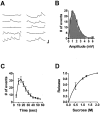Modulation of the readily releasable pool of transmitter and of excitation-secretion coupling by activity and by serotonin at Aplysia sensorimotor synapses in culture
- PMID: 12486160
- PMCID: PMC6758440
- DOI: 10.1523/JNEUROSCI.22-24-10671.2002
Modulation of the readily releasable pool of transmitter and of excitation-secretion coupling by activity and by serotonin at Aplysia sensorimotor synapses in culture
Abstract
Short-term homosynaptic depression and heterosynaptic facilitation of transmitter release from mechanoreceptor sensory neurons of Aplysia are involved in habituation and sensitization, respectively, of defensive withdrawal reflexes. We investigated whether synaptic transmission is regulated in these forms of plasticity by means of changes in the size of the pool of transmitter available for immediate release [the readily releasable pool (RRP)] or in the efficacy of release from an unchanging pool. Using sensorimotor synapses formed in cell culture, we estimated the number of transmitter quanta in the RRP from the asynchronous release of neurotransmitter caused by application of a hypertonic bathing solution. Our experiments indicate that the transmitter released by action potentials and by hypertonic solution comes from the same pool. The RRP was reduced after homosynaptic depression of the EPSP by low-frequency stimulation and increased after facilitation of the EPSP by application of the endogenous facilitatory transmitter serotonin (5-HT) after homosynaptic depression. However, although the fractional changes in the RRP and in the EPSP were similar for both synaptic depression and facilitation when depression was induced by repeated hypertonic stimulation, the changes in the EPSP were significantly greater than the changes in the RRP when depression was induced by repeated electrical stimulation. These observations indicate that homosynaptic depression and restoration of depressed transmission by 5-HT are caused by changes in both the amount of transmitter available for immediate release and in processes involved in the coupling of the action potential to transmitter release.
Figures







Similar articles
-
Changes in the readily releasable pool of transmitter and in efficacy of release induced by high-frequency firing at Aplysia sensorimotor synapses in culture.J Neurophysiol. 2004 Apr;91(4):1500-9. doi: 10.1152/jn.01019.2003. Epub 2003 Nov 26. J Neurophysiol. 2004. PMID: 14645384
-
Long-term facilitation in Aplysia involves increase in transmitter release.Science. 1988 Jan 15;239(4837):282-5. doi: 10.1126/science.2892269. Science. 1988. PMID: 2892269
-
Pairing-specific, activity-dependent presynaptic facilitation at Aplysia sensory-motor neuron synapses in isolated cell culture.J Neurosci. 1994 Jan;14(1):368-83. doi: 10.1523/JNEUROSCI.14-01-00368.1994. J Neurosci. 1994. PMID: 8283244 Free PMC article.
-
Postsynaptic regulation of the development and long-term plasticity of Aplysia sensorimotor synapses in cell culture.J Neurobiol. 1994 Jun;25(6):666-93. doi: 10.1002/neu.480250608. J Neurobiol. 1994. PMID: 8071666 Review.
-
Insights into a molecular switch that gates sensory neuron synapses during habituation in Aplysia.Neurobiol Learn Mem. 2009 Sep;92(2):155-65. doi: 10.1016/j.nlm.2009.03.006. Epub 2009 Apr 2. Neurobiol Learn Mem. 2009. PMID: 19345275 Free PMC article. Review.
Cited by
-
Presynaptic and postsynaptic mechanisms of synaptic plasticity and metaplasticity during intermediate-term memory formation in Aplysia.J Neurosci. 2010 Apr 21;30(16):5781-91. doi: 10.1523/JNEUROSCI.4947-09.2010. J Neurosci. 2010. PMID: 20410130 Free PMC article.
-
BK Channels Mediate Synaptic Plasticity Underlying Habituation in Rats.J Neurosci. 2017 Apr 26;37(17):4540-4551. doi: 10.1523/JNEUROSCI.3699-16.2017. Epub 2017 Mar 27. J Neurosci. 2017. PMID: 28348135 Free PMC article.
-
The role of specific isoforms of CaV2 and the common C-terminal of CaV2 in calcium channel function in sensory neurons of Aplysia.Sci Rep. 2023 Nov 18;13(1):20216. doi: 10.1038/s41598-023-47573-z. Sci Rep. 2023. PMID: 37980443 Free PMC article.
-
Calcium-activated proteases are critical for refilling depleted vesicle stores in cultured sensory-motor synapses of Aplysia.Learn Mem. 2005 Jul-Aug;12(4):414-22. doi: 10.1101/lm.92105. Learn Mem. 2005. PMID: 16077020 Free PMC article.
-
Release properties of individual presynaptic boutons expressed during homosynaptic depression and heterosynaptic facilitation of the Aplysia sensorimotor synapse.Front Cell Neurosci. 2013 Sep 24;7:165. doi: 10.3389/fncel.2013.00165. eCollection 2013. Front Cell Neurosci. 2013. PMID: 24068986 Free PMC article.
References
Publication types
MeSH terms
Substances
Grants and funding
LinkOut - more resources
Full Text Sources
